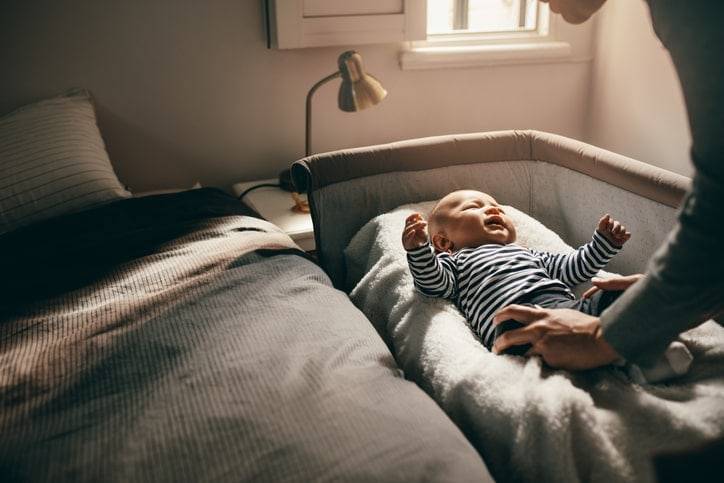Infant sleep training: Gentle alternatives to “cry it out”

When we hear about infant sleep training, we often think of babies left alone in their cribs to cry themselves to sleep. But there are alternatives to such an approach. Parents don’t have to close the door on their infants to improve sleep outcomes — or help their babies learn self-soothing.

Infant sleep training technique #1: Positive routines with faded bedtime
The theory behind this sleep training method is simple: Children will fall asleep more easily if they are led through a series of predictable, pleasant, quiet, bedtime rituals. But if you pick a bedtime that is too early, children won’t feel drowsy, and they may resist falling asleep.
With this program, you train your infant to associate the bedtime routine with feeling drowsy, and you do this by delaying the start of the routine until you are sure your baby is ready to fall asleep.
This requires that you pay close attention to your baby’s sleep patterns. Put aside the schedule that you want your baby to adopt in the future. What’s happening now? At what time of night does your baby fall asleep naturally? Embrace this as your current, official bedtime, and introduce a soothing routine that leads up to it each night: Up to 20 minutes of quiet, calm, pleasant activities.
Because your baby is already inclined to fall asleep at this time, you shouldn’t experience much trouble, and — by repeating the process on multiple nights — your baby will learn to associate the new bedtime routine with falling asleep. As this lesson is learned, you will gradually shift your schedule, making bedtime 10-15 minutes earlier every few days until the desired, final bedtime is reached (Adams and Rickert 1989). For full instructions on using this technique, read my Parenting Science article, “Bedtime fading: An evidence-based, step-by-step guide (with examples).”
Will it work?
When researchers tested the approach in a randomized, controlled study of children aged 18-48 months, they got good results (Adams and Rickert 1989). Bedtime routines with faded bedtime was as effective for reducing bedtime tantrums as was graduated extinction, or the “Ferber method” (an approach to infant sleep training that involves leaving babies alone to “cry it out” for increasingly lengthy periods of time.)
Infant sleep training technique #2: Positive routines “a la carte”
Maybe your baby is already acting sleepy at your preferred bedtime. You just wish your baby would settle down sooner — or sleep longer at night. Can bedtime routines help if they are implemented on their own?
Jodi Mindell and colleagues have tested positive routines in isolation (without the faded bedtime component) and found evidence that routines alone can deliver benefits. The researchers recruited 206 mother-infant pairs, and randomly assigned 132 of them to begin a nightly bedtime routine. The routine itself was comprised of three steps:
- a bath (lasting at least 5 minutes),
- a massage (lasting at least 3 minutes), and
- some quiet activities, like cuddling or lullabies.
Parents were instructed to keep the routine relatively short (so that it ended withint 30 minutes of completing the bath), but they were free to put their children to bed in whatever way was customary for them. Some parents chose to set their babies down to sleep while they were still awake. Others allow their babies to fall asleep while they were being held or rocked.
What happened? By the third night, babies were falling asleep more easily, and staying asleep longer, with the timing of their longest nighttime bout increasing by approximately 17 minutes (Mindell et al 2017).
Other experimental studies have been harder to interpret, because they assigned parents to use “positive routines” in combination with a variety of additional infant sleep training tactics (e.g., Hohman et al 2022; Paul et al 2016). Thus, it isn’t possible to say which parts of the experimental treatments were responsible for observed outcomes (Mindell et al 2006).
But overall, I think we have strong reason to think that bedtime routines (with or without bedtime fading) are a good bet. It makes sense that repeating the same, pleasant, calming activities — night after night — would help young children relax at night, and correlational studies indicate that positive bedtime routines are linked with longer sleep duration and fewer disruptive night wakings (Mindell and Williamson 2018; Tsai et al 2022).
In fact, in an international a survey of more than 10,000 children, researchers found that individuals who had started bedtime routines before 12 months tended to have better sleep outcomes as preschoolers: They were in the habit of falling asleep more quickly, and they tended to get more sleep overall (Mindell et al 2015).
Infant sleep training technique #3: Extinction with parental presence
With this approach to infant sleep training, you put your baby to bed while he or she is still awake, and you sit nearby (so your baby can see or hear you) until your baby falls asleep. You repeat the process on subsequent nights, but — as time goes by — you pay progressively less attention to your baby, and move physically farther away.
For instance, if you are starting out with a baby who is accustomed to lots of touching and social interaction at bedtime, you begin by trying to touch your baby less. Then, on the following nights, you curb your tendency to talk. Next, you spend less time looking at your baby, and you move your chair farther and farther away from your infant’s bed. You can read, or do some other quiet activity, while you keep up your vigil. But the goal is to becoming increasingly withdrawn and boring. When your child finally falls asleep, you can leave the room.
After you’ve had success with this for a few nights (your baby falling asleep without touching or interacting with you) you can add a new element to the procedure: Once each night — shortly after setting your baby down in bed — try leaving the room for a few seconds, returning before your baby starts to cry. This will help your baby learn that he or she can lie awake, alone, without being distressed.
What should you do if your baby awakens in the middle of the night? Take the same overall approach, but try to wait a bit (1-3 minutes) before appearing to your child’s bedside (Skuladottir 2003). The goal is to give your baby the opportunity to fall back to sleep without your presence.
What evidence supports the use of “extinction with parental presence”?
When Icelandic researchers tested this approach on 115 sleep-disturbed children (aged 6-23 months), babies slept longer and experienced fewer night wakings (Skuladottir 2003). Another study, conducted on 50 sleep-disturbed babies in Israel, has also reported successful results (Sadeh 1994). And investigators in Australia have conducted trials that pitted “extinction with parental presence” against an alternative that involved “controlled crying.”
In one of these studies, Stephen Matthey and Rudi Črnčec randomly assigned 8 of 16 families to a program of sleep training called “parental presence with minimal check,” in which parents “feign sleep inside the infant’s room” before responding to the baby’s cries. The other 8 families were assigned to a program that required parents to leave their crying babies alone in another room. When researchers analyzed short-term outcomes, they found that both approaches were equally effective (Matthey and Črnčec 2012).
In the other study, Sarah Blunden and colleagues randomly assigned 31 mother-infant pairs to one of three groups:
- extinction with parental presence,
- controlled crying (in which parents would leave their babies alone for up to 3 minutes at a time), and
- a control group (in which parents followed whatever sleep tactics they wished).
The researchers monitored the babies’ sleep patterns over the subsequent weeks, and found no differences in overall sleep duration between groups. But babies in the extinction with parental presence group experienced fewer night wakings, and their mothers showed less evidence of distress and depression (Blunden et al 2022).
The takeaway? It appears that parents don’t have to close the door on babies to encourage the development of self-soothing skills. And by going with techniques that minimize crying, parents may avoid some of the stresses that can accompany sleep training.
More reading about baby sleep
For more information about coping with sleep problems, try these Parenting Science articles:
References: Infant sleep training
Adams LA and Rickert VI. 1989. Reducing bedtime tantrums: Comparison between positive bedtime routines and graduated extinction. Pediatrics 84(5): 756-761.
Blunden S, Osborne J, and King Y. 2022. Do responsive sleep interventions impact mental health in mother/infant dyads compared to extinction interventions? A pilot study. Arch Womens Ment Health. 25(3):621-631.
Hohman EE, Savage JS, Marini ME, Anzman-Frasca S, Buxton OM, Loken E, Paul IM. 2022. Effect of the INSIGHT Firstborn Parenting Intervention on Secondborn Sleep. Pediatrics. 150(1):e2021055244.
Matthey and Črnčec. 2012. Comparison of two strategies to improve infant sleep problems, and associated impacts on maternal experience, mood and infant emotional health: a single case replication design study. Early Hum Dev. 88(6):437-42.
Mindell JA, Kuhn B, Lewin DS, Meltzer LJ, Sadeh A and the American Academy of Sleep Medicine. 2006. Behavioral treatment of bedtime problems and night wakings in infants and young children. Sleep 29: 1263-1281.
Mindell JA, Du Mond CE, Sadeh A, Telofski LS, Kulkarni N, Gunn E. 2011. Efficacy of an internet-based intervention for infant and toddler sleep disturbances. Sleep. 34(4):451-8.
Mindell JA, Li AM, Sadeh A, Kwon R, and Goh DY. 2015. Bedtime routines for young children: a dose-dependent association with sleep outcomes. Sleep 38(5): 717-722.
Mindell JA, Leichman ES, Lee C, Williamson AA, Walters RM. 2017. Implementation of a nightly bedtime routine: How quickly do things improve? Infant Behav Dev. 49:220-227.
Mindell JA and Williamson AA. 2018. Benefits of a bedtime routine in young children: Sleep, development, and beyond. Sleep Med Rev. 40:93-108.
Paul IM, Savage JS, Anzman-Frasca S, Marini ME, Mindell JA, Birch LL. 2016. INSIGHT Responsive Parenting Intervention and Infant Sleep. Pediatrics. 138(1):e20160762.
Sadeh A. 1994. Assessment of intervention for infant night waking: Parental reports and activity-based home monitoring. J Consult Clin Psychol 62(1):63-8
Skuladottir A and Thome M. 2003. Changes in infant sleep problems after a family-centered intervention. Pediatric Nursing 29(5):375-8.
Tsai SY, Lee CC, Tsai HY, Tung YC. 2022. Bedtime routines and objectively assessed sleep in infants. J Adv Nurs. 78(1):154-164.
Written content last modified 7/2022; new image added 3/2022
Portions of the text are derived from earlier versions of this article, written by the same author
image by jacoblund / istock















